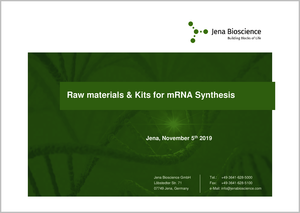Nucleotídeos para Modificação de mRNA
Downloads
Produtos
Selected References
[1] Tavernier et al. (2011) mRNA as gene therapeutic: How to control protein expression. Journal of controlled disease 150:238.
[2] Karikó et al. (2011) Generating the optimal mRNA for therapy: HPLC purification eliminates immune activation and improves translation of nucleoside-modified, protein-encoding mRNA. Nuclei Acids Res. 39 (21):9329.
[3] Pascolo et al. (2006) Vaccination with messenger RNA. In: Methods in Molecular Medicine 127 (Saltzmann). Humana Press.
[4] Kormann et al. (2011) Expression of therapeutic proteins after delivery of chemically modified mRNA in mice. Nature Biotechnology 29 (2):154.
[5] Karikó et al. (2008) Incorporation of Pseudouridine into mRNA Yields Superior Nonimmunogenic Vector With Increased Translational Capacity and Biological Stability. Mol. Ther. 16 (11):1833.
[6] Karikó et al. (2005) Suppression of RNA Recognition by Toll-like Receptors: The Impact of Nucleoside Modification and the Evolutionary Origin of RNA. Immunity 23:165.
[7] Anderson et al. (2011) Nucleoside modifications in RNA limit activation of 2'-5'-oligoadenylate synthetase and increase resistance to cleavage by RNAse L. Nuclei Acids Res. 39 (21):9329.
[8] Warren et al. (2011) Highly Efficient Reprogramming to Pluripotency and Directed Differentiation of Human Cells with Synthetic Modified mRNA. Cell Stem Cell 7:618.
[9] Andies et al. (2015) N (1)-methylpseudouridine-incorporated mRNA outperforms pseudouridine-incorporated mRNA by providing enhanced protein expression and reduced immunogenicity in mammalian cell lines and mice. J. Control. Release 217:337.
[10] Li et al. (2016) Effects of Chemically Modified Messenger RNA on Protein Expression Bioconjugate Chem. 27 (3):849.

